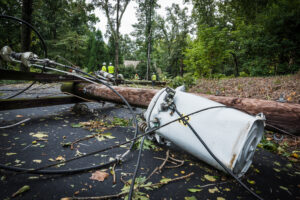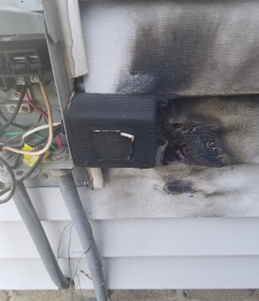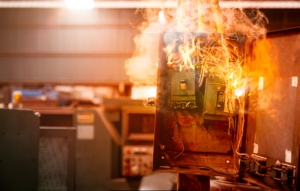Surge and Lightning Damage to Electronics
Surge and lightning are among the top claimed causes of loss to electronics and electrically powered specialty items. The Insurance Information Institute cited almost 61,000 homeowners insurance claims included lightning damage in 2021 alone, with an average settlement of more than $21,000 per claim.
With so much at stake, it’s important to verify the cause of loss to equipment before settling a claim, but it may be difficult to determine whether lightning, high voltage surge, or something else is responsible. An expert familiar with the involved equipment is an invaluable resource, as is knowing the basics about each peril and how it affects electronic devices to help you prepare to address these claims accurately.
Experts use visual evidence, data, and testing to determine whether damage to electronics and electrical systems is due to lightning, surge, or another cause.
Lightning
According to the National Weather Service, lightning strikes within the United States about 25 million times per year, and an average stroke carries about 30 million volts. The power of this phenomenon poses a serious threat to electronics in a home, where the current is typically 120 or 240 volts. Lightning damage is rare. While lightning was the reported cause of loss in 59% of consumer electronic claims StrikeCheck assessed in 2022, it was found to be the actual cause in only 2% of them.
A lightning strike may lead to fire in the electrical system as the lightning seeks to ground itself through the conductive wiring.
Evidence that experts consider when assessing property for reported lightning damage includes:
- Arcing
- Ghosting, or dark, soot-like deposits on outlets
- Direct strikes to trees or other nearby elements
- Blown-apart structural elements, such as chimneys or siding
- Attic fires, soot, and charring
All onsite evidence should be considered in conjunction with weather data and a general understanding of lightning’s characteristics. A lightning verification report often precludes the presence of lightning in the area on or around the date of loss, a valuable tool in eliminating it as a cause.
High Voltage Surge
High voltage surges are common causes of loss that are frequently reported as lightning. An expert assessment can distinguish between surges and lightning damage or other perils like wear and tear. Surges are caused by a voltage fluctuation, are confined to the electrical system, and could result from one or more of the following:
- Lightning: When power lines are struck by lightning, voltage well in excess of the standard 120 or 240 volts travels to nearby connected properties.
- Electrical Grid Issues: Storm or impact damage to a power line or transformer may cause a power outage. When power is restored, the sudden influx of electricity can cause surges.
High-Power Devices: Many surges originate from heavy use of high-power devices. If multiple items that require a lot of electricity power on simultaneously, it can lead to a surge.

Lightning and surge damage can affect many systems and items within a home. Here are a few examples of how commonly reported electronics and systems react to these perils.
Consumer Electronics
Most of the damage reported as lightning is identified as another peril in an assessment, and some equipment is even determined to be undamaged. However, the burst of voltage a surge supplies is a threat to consumer electronics like computers, televisions, routers, and more.
Most of these items use integrated circuits, which are silicon chips containing hundreds to billions of electronic components – essentially tiny power plants within the device. Any voltage surge puts excessive stress on these components. When too-high voltage travels through the wires or communication cables, the surge puts excessive stress on the components within the integrated circuit.
Signs of surge include devices suddenly shutting off or failing to power on, flashing displays, or a burning odor around affected devices. A surge protector can safeguard consumer electronics from high voltage surge if the devices are properly connected to it, though it does nothing to prevent damage from a direct lightning strike
Large Appliances
Appliances like dishwashers, clothes dryers, refrigerators, water heaters, and others are often reported to have lightning or surge damage. However, damage from lightning is determined to be the cause of loss less than 1% of the time.
It should be noted that surge can occur from indirect lightning, as a strike to a close power supply, structure, or tree may cause voltage to travel into the house and damage the appliances. According to the National Institute of Standards and Technology, this is particularly true in the case of appliances with electrical rather than mechanical controls because surges can damage the control board.
In the event of a power outage, appliances with motors, such as refrigerators, may be especially vulnerable. If the motor doesn’t have enough starting power once the electricity is restored, the wiring within it can overheat and trigger the thermal protector.
Electrical Wiring
As with appliances and consumer electronics, lightning damage to electrical wiring is rare. With either lightning or surge, excessive voltage travels through a home’s wiring, and its effects are often felt by items plugged into the electrical system.
However, wiring itself may be affected if it’s not up to standard. Age, faulty installation, animal infestations, and more can contribute to a higher risk when wires are required to conduct too much current. If the wiring overheats, this could lead to more than just electrical failure; fire becomes an added concern.
With so many potential damages and evidence to consider, it can be difficult to distinguish between causes of loss to electronic equipment. An expert familiar with the claimed equipment can perform tests and confirm whether it has sustained damage from a high voltage surge. Though this cause of loss is common, it’s important to note that items with surge damage can sometimes be repaired.
If you have a claim involving lightning or surge damage to electronics or other electrically powered devices, don’t settle without an assessment. Submit an assignment to StrikeCheck to determine the cause of loss and whether items can be returned to pre-loss condition without a replacement. You can also request a lightning verification report to confirm the presence of lightning surrounding the loss location.


